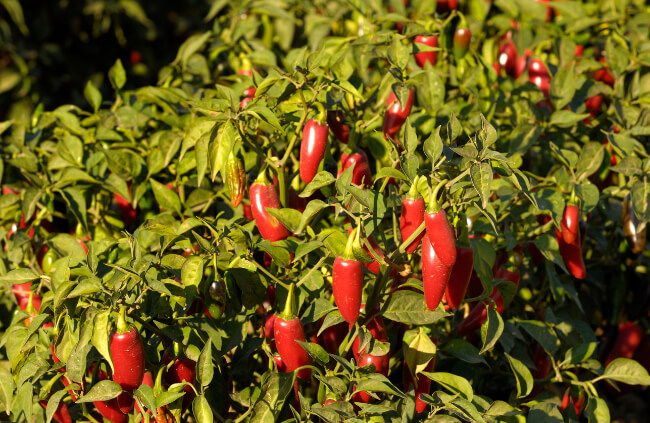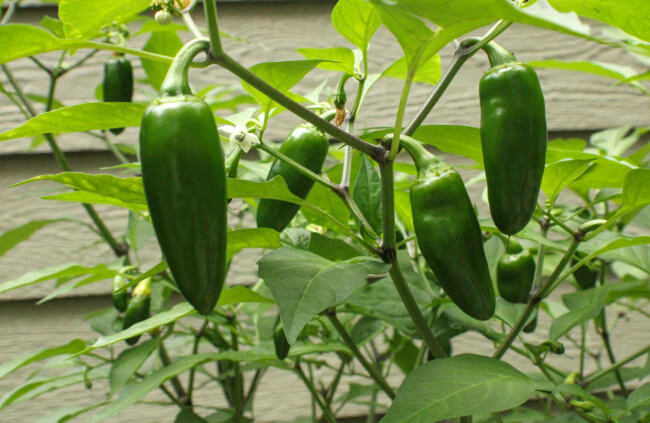If you want to bring a bit of spiciness into your garden, then growing jalapenos might just be the perfect solution! Not only are you able to reap the nutritional and culinary benefits of these popular chilli peppers but it's also surprisingly easy to do.
In this in-depth guide, we will explore everything from planting techniques, and additional care required (including tips for combating pests) right up to harvesting and storage techniques. Everything that you need to become an expert at cultivating juicy jalapenos can be found here!
More...
How to Grow Jalapenos in Australia

Preparing the Soil for Growing Jalapenos
When it comes to growing Capsicum annuum ‘Jalapeño’, commonly known as Jalapenos, the type of soil you use can make a big difference in the success of your harvest. For optimal growth, jalapenos thrive in well-draining soil that is rich in nutrients and has a slightly acidic pH level ranging between 6.0 to 6.5. A mixture of soil, compost, and perlite can create the perfect balance for your plants.
To prepare the soil, loosen it up with a garden fork or tiller and then mix in compost to enrich it with the necessary nutrients. Adding perlite will help improve drainage. Once your soil is prepared, you can plant your jalapeno seeds or seedlings and enjoy the spicy harvest that will soon follow.
Also, make sure to use raised beds or containers for growing if your soil is too heavy and doesn’t drain well. When thinking about how to grow jalapenos, raised beds can be a viable option for creating the perfect environment. Keep in mind that jalapenos need a lot of sunlight to thrive, so make sure you choose an area of your garden that receives plenty of sun throughout the day.
As an added bonus, raised beds or containers can also help protect your plants from diseases and pests. Your soil will also warm up faster in the spring, allowing you to get a head start on your planting season. Don't forget to mulch around the planting area for additional protection.
Ideal Conditions for Planting Jalapenos

Jalapenos are a versatile and tasty pepper that can add a spicy kick to many dishes. If you're looking to grow jalapenos in your garden, it's important to know when and where to plant them for optimal growth.
Ideally, jalapenos should be planted in the spring or early summer when the soil has warmed up and there is no danger of frost. They thrive in warm, sunny locations with well-draining soil.
If you live in a cooler climate, consider growing jalapenos in containers so you can move them indoors during the colder months.
Jalapenos prefer a moderate climate with temperatures between 18 to 26°C. With the right conditions and care, you can look forward to a bountiful harvest of fresh jalapenos from your own garden.
Additionally, you can experiment with different varieties of jalapenos to find the one that's best suited for your climate and preferences. For example, if you live in a cooler area, try growing milder jalapenos such as the New Mexico or California varieties.
On the other hand, if your climate is warm and humid, hotter varieties such as the Serrano or Jaloro may thrive better. Keep in mind that hotter varieties require more care and attention.
Finally, make sure to research and follow any additional care instructions for your specific type of jalapeno before planting. Things such as when and how to water, fertilising, and pest control can vary from one variety to the next.
Planting and Caring for Jalapenos

Planting, watering, and maintaining your own jalapeno plants can be a rewarding experience, both in terms of satisfying your taste buds and proving your green thumb prowess.


Get Your Free Guide:
Master Growing Australian Natives eBook
A Must Have Complete Guide for Every Australian Garden
Get Your Free Guide:
Master Growing Australian Natives eBook
A Must Have Complete Guide for Every Australian Garden
To begin with, choose a sunny spot in your garden with well-draining soil to plant your seedlings in. Jalapenos need plenty of sunlight, so make sure to pick an area that gets at least six hours of direct sunlight.
As they grow, water the plants deeply once a week, ensuring the soil is moist up to a depth of around 6 inches. Be careful not to overwater your jalapenos, as this can lead to root rot and other issues. Once your jalapeno plants begin to flower, pinch out the first few blossoms to encourage bushier growth.
Lastly, be sure to keep an eye out for pests and disease, and fertilise your plants a few times over the growing season to promote healthy growth. With a little time and care, you'll soon be harvesting fresh and fiery jalapenos right from your own garden. Remember to wear gardening gloves when harvesting and handling the peppers to avoid skin irritation.
Another safety tip is to wash your hands and any surfaces that may have come in contact with jalapenos before touching your eyes, nose, or mouth. You can also wear protective glasses to avoid any accidental contact with the hot pepper.
The importance of Fertilising Your Plants Properly
For a thriving garden, the importance of fertilising your plants properly cannot be overstated. The right balance of nutrients is crucial to ensure that your plants grow strong, healthy and produce a bountiful harvest. Using compost or manure is an excellent way to enrich your soil and promote growth naturally.
These organic materials contain essential elements such as nitrogen, potassium, and phosphorus which nourish the soil and enrich plants. Care must be taken to ensure that the right amount of compost or manure is used and that it is incorporated into the soil correctly.
Proper fertilisation can not only improve the health of your plants but also protect the environment by reducing the need for chemicals. So, tending to your garden with the right combination of care, attention, and natural fertilisation can help you achieve a stunning green space that is both healthy and sustainable.
Not to mention, you'll get to enjoy a delicious and spicy bounty of jalapenos from your own garden. In addition to jalapenos, you'll also be able to enjoy a wide variety of fruits and vegetables from your garden. Growing your own food at home is an enjoyable experience that can provide long-lasting rewards. With the right conditions and care, anyone can create a beautiful and bountiful garden of their own.
Various Pest You May Encounter When Growing Jalapenos
When growing jalapenos, gardeners must take precautions to prevent pests from wreaking havoc on their plants. There are several common pests that may pose a threat, such as aphids, spider mites, and whiteflies.
- Aphids are small, soft-bodied insects that often congregate on the underside of leaves and feed on the plant's sap.
- Spider mites are tiny arachnids that suck the fluids out of the leaves, causing them to yellow and die.
- Whiteflies are another nuisance, as they infest plants in large numbers and feed on their leaves, ultimately leading to stunted growth and reduced yield.
It's essential to monitor your jalapeno plants regularly to catch any signs of pest infestation early on and take appropriate measures to combat the issue. With proper care, you can combat pests and grow a healthy, thriving jalapeno crop.
For example, you can use natural methods such as companion planting or introducing beneficial insects like ladybugs to your garden. Additionally, you can spray your plants with a solution of water and herbal extracts such as neem oil or garlic to deter pests from feeding on them.
Finally, make sure to clean up any affected leaves or debris in the surrounding area, as this will help prevent the pests from multiplying. With a little effort and care, you can protect your jalapenos from pests and enjoy a delicious harvest in the end.
How to Harvest and Store Jalapeno Peppers

If you're a fan of spicy food, then jalapeno peppers are an absolute must-have in your kitchen. Not only do they pack a punch of heat, but they're also incredibly versatile and can be used in a variety of dishes. When it comes to harvesting jalapeno peppers from your garden, it's important to do so at the right time.
You want to make sure that the peppers have reached their full size and have turned a deep shade of green. Once you've plucked them from the plant, it's time to think about storing them for later use. There are a few different methods you can use, ranging from freezing to canning.
No matter what method you choose, the end result will be a stockpile of delicious jalapeno peppers that will add some serious flavour to your meals. Also, don't forget to add some of the peppers to your next salsa or guacamole recipe for a kick of extra heat.
Additionally, you can also dehydrate or pickle your jalapenos for long-term storage. Whichever method you choose, with a little bit of preparation and care, your jalapeno peppers will be ready to enjoy whenever you're in the mood for some spicy food.
How to Use Jalapenos in the Kitchen
Once you have successfully grown and harvested a bounty of jalapenos, it's time to enjoy them in the kitchen. From tacos to nachos or even grilled vegetables, jalapenos add an extra layer of flavour and zing to just about any dish.
The possibilities are endless, and you can get creative with your recipes by adding other ingredients such as onions, garlic, tomatoes, or cilantro to balance out the heat of the jalapenos. Do keep in mind that jalapenos can be quite spicy so go light on them if you're not a fan of fiery dishes.
Finally, be sure to practise safe handling of jalapenos while cooking and always wear gloves when chopping them. This will help prevent any skin irritation or burning sensations. With a little bit of effort and care, you can easily enjoy the fruits – or should we say peppers – of your labour in the kitchen.

Here are some recipes to consider:
- Grilled Jalapeno Popper Stuffed Peppers – these delicious peppers are filled with a creamy cheese filling and topped with crunchy bacon for the perfect appetiser.
- Baked Spicy Chicken Taquitos – these crispy and flavorful taquitos are sure to be a hit at any party.
- Jalapeno Cheddar Burgers – jazz up your burgers with some jalapenos and cheddar cheese for a delicious kick of flavour.
- Sweet and Spicy Bacon Wrapped Shrimp – this dish has the perfect balance of sweetness from the honey and heat from the jalapenos.
- Spicy Fried Rice – this flavorful fried rice is loaded with vegetables, bacon, and plenty of spicy jalapeno peppers.
Wrapping Up Our Jalapenos Guide
So what are you waiting for? It's time to get out there and start growing your own jalapenos! With the right conditions and care, you can achieve a fruitful harvest of fresh jalapenos in no time.
Not to mention, with the wide variety of recipes available, you can enjoy your own jalapeno bounty in the kitchen as well. So get growing and start spicing up your meals today!
The key to success when growing jalapenos is knowing your soil, when and where to plant them, the planting process, proper fertilisation methods, pest control, and harvesting and storing your peppers. Armed with this information you are sure to grow a bountiful harvest of delicious jalapenos for all of your cooking needs.
Growing jalapenos is easy if you follow the simple steps outlined in this guide. With a little bit of knowledge and effort from each step listed above, you can easily produce a large number of peppers without any major issues.
Capturing peak flavour and keeping all those flavours locked away until taste buds are ready for them will have you hooked on growing jalapeno peppers as it is so rewarding!
Keep in mind that jalapenos need to be harvested at the right time in order for you to achieve the best flavour and texture. Jalapenos store well so you can stock up on them and enjoy them year-round.
Have a few recipes on hand to spice up your meals with the delicious flavour of jalapenos. So what are you waiting for? Get out there, get growing, and enjoy the sweet (or spicy) rewards of jalapenos!
Published on July 25, 2023 by Gary Clarke
Last Updated on September 20, 2024




